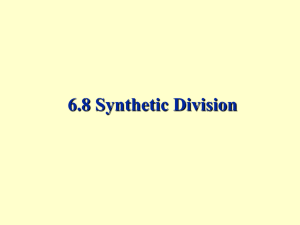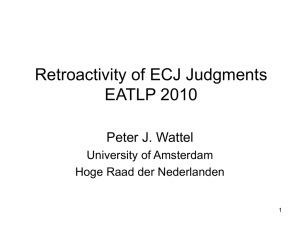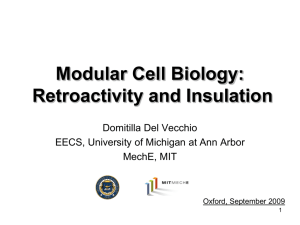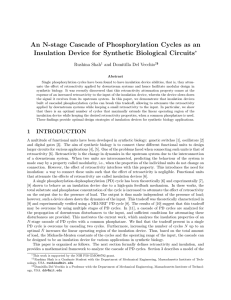Introduction to Synthetic Biology: Challenges and Opportunities for
advertisement
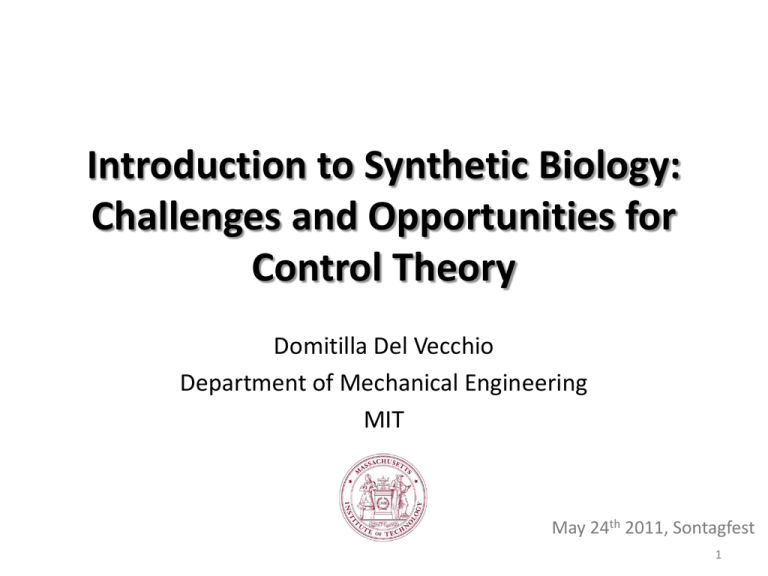
Introduction to Synthetic Biology: Challenges and Opportunities for Control Theory Domitilla Del Vecchio Department of Mechanical Engineering MIT May 24th 2011, Sontagfest 1 Molecular Systems Biology and Eduardo CDC 2005 Tutorial Session an EJC 2005: Molecular Systems Biology and Control IET 2004: Some New Directions in Control Theory Inspired by Biology 2 Outline • What is synthetic biology? • Examples of working circuit modules • Challenges/opportunities 3 Why to Design Synthetic Bio-molecular Systems? MEDICAL APPLICATIONS (e.g. targeted drug delivery) ALTERNATIVE ENERGY (e.g. bio-fuels) Making bacteria that… - Produce hydrogen or ethanol - Transform waste into energy COMPUTING APPLICATIONS (e.g. molecular computing) BIO-SENSING (e.g. detecting pathogens or toxins) 4 Synthetic Biology: A Historical Perspective Birth of Synthetic Biology? Birth of Genetic Engineering recombinant DNA 1961 1968 1978 1980s Insulin became first recombinant DNA drug 2000 K. Mullis: Polymerase Chain Reaction (PCR) (exponential amplification of DNA) Early ``working’’ synthetic circuits in E coli: Gardner et al. toggle switch, Elowitz and Leibler repressilator First reporter gene was isolated: green fluorescent protein (GFP) W. Arber discovers restriction enzymes (Nobel Prize winner) Jacob and Monod introduce for the first time the concept of operon regulation 1983 gene 5 Key Enabling Technology Recombinant DNA technology: allows to cut and paste pieces of DNA at desired locations cleaved by restriction enzymes Chromosome Chromosome recombinant DNA Plasmids Bacterium Extraneous DNA Fluorescent Proteins: allow through fluorescence microscopy to measure the concentration of a protein and thus the level of expression of the corresponding gene gene gfp 6 Outline • What is synthetic biology? • Examples of working circuit modules • Challenges/opportunities 7 Early modules fabricated in vivo Rosenfeld et al 2002 Becskei and Serrano 2000 Gardner et al 2000 Bistable modules Autoregulated modules Atkinson et al 2003 Relaxation oscillators Elowitz and Leibler 2000 Loop oscillators 8 Self repressed gene: Noise properties Coefficient of variation Negative autoregulation decreases noise on the steady state value negative feedback x autoregulated Becskei and Serrano, Nature 2000 Math analysis in Singh and Hespanha, CDC 2008 Negative autoregulation shifts frequency content to high frequency Simulation data (SSA) Experimental data 9 Austin, Allen, McCollum, Dar, Wilgus, Sayler, Samatova, Cox and Simpson. Nature 2006 Loop oscillators: The repressilator Cyclic feedback system: Can use - Mallet-Paret and Smith (1990) - Hastings, J. Tyson, D. Webster (1977) El Samad, Del Vecchio and Khammash, ACC 2004 10 Elowitz and Leibler, Nature 2000 Activator-Repressor Clock A LacI-rep NRI-act glnG B glnKp lacI IPTG Atkinson, Savageau, Myers, and Ninfa, Cell 2003 Experimental data (Courtesy of Ninfa Lab at Umich) (Cell population measurements) Del Vecchio, ACC 2007 Key design principle: sufficiently fast activator dynamics compared to repressor dynamics 11 Outline • What is synthetic biology? • Examples of working circuit modules • Challenges/opportunities 12 Challenges Circuits are intrinsically stochastic and there is cell-cell variability - How to design circuits that are robust to stochastic fluctuations? - What are the fundamental limits of feedback? - How to enforce cell-cell synchronization? Courtesy of Elowitz Lab Limited measurements. Problems: - Where to locate the sensors (reporters) to obtain state information? - What are the limits to what can be identified about the state and parameter values? Most microscopic rates are unknown: - Given a desired behavior, what is the most robust topology that realizes it? - How do we over-design systems? (need find parameter space where prescribed behavior is attained) 13 Challenges How to handle metabolic burden by synthetic circuits on the cell? Need for control of “biomolecular power networks” and adaptation/robustness to demand of new synthetic circuits WORKING “MODULES” NOT WORKING INTERCONNECTIONS ! Retroactivity Unfortunately, modular composition fails: Why? How to enforce it? 14 A “system concept” to explicitly model retroactivity u y Retroactivity to the input r s Familiar Examples: Related works: Willem’s work and Paynter formalism Retroactivity to the output The interconnection changes the behavior of the upstream system 15 D. Del Vecchio, A. J. Ninfa, and E. D. Sontag, Molecular Systems Biology, 2008 Insulation devices for attenuating retroactivity In general, we cannot design the downstream system (the load) such that it has low retroactivity. But, we can design an insulation system to be placed between the upstream and downstream systems. u y s r≈ 0 1. The retroactivity to the input is approx zero: r≈0 2. The retroactivity to the output s is attenuated The basic feedback scheme: 0 as G infinity 16 Effect of retroactivity on the dynamics: Experimental results UT Gln PII PII-UMP UR 1 ω𝐵 ∝ λ 𝑁 λ= 𝑘 Isolated NRII 𝐷 (effective load) Connected C Retroactivity decreases the bandwidth of the cycle. Hence, the information processing ability is deteriorated while the noise filtering ability is improved. Experimental system: Ventura, Jiang, Van Wassenhove, Del Vecchio, 17 Merajver, and Ninfa, PNAS, 2010 Insulation is reached by increasing the gain: Experimental results UT Gln PII PII-UMP UR G∝ 𝑘1 𝑈𝑇 G’∝ 𝑘2 𝑈𝑅 NRII C Recall: By theory: increasing the amounts of UT and UR enzymes, the effect of retroactivity should be attenuated Experimental Results UT, UR=0.03 μM UT, UR=0.1 μM UT, UR=1 μM Isolated Connected Covalent modification cycles can be re-engineered to function as insulation devices! Under Review 18 New mechanism for insulation enabled by system structure Large Claim: Under stability assumptions on the x dynamics, if G is large enough then (after a short initial transient) the effect of s on x is arbitrarily attenuated (independently of G’) Interconnection through binding/ unbinding “Proof” x(t) does not depend on y on the slow manifold Can be applied to easily tune most signaling networks so they work as insulators, including MAPK cascades and phosphotransfer systems (Ypd1-Skn7 pathway) Jayanthi and Del Vecchio, IEEE TAC 2010 19 Happy Birthday Eduardo! 20 Parts, Devices, Systems: Synthetic Biology as an Engineering Discipline Baker, Church, Collins, Endy, Jacobson, Keasling, Modrich, Smolke, and Weiss. Scientific American, 2006 21 Toggle switch A B B A Symmetric design 1 Iptg temperature 2 Gardner et al., Nature 2000 22 Retroactivity has dramatic effects on the dynamics of biomolecular modules Downstream component (connected) (isolated) s Reduced System Retroactivity measure 23 D. Del Vecchio, A. J. Ninfa, and E. D. Sontag, Molecular Systems Biology, 2008 A phosphorylation-based design for a biomolecular insulation device Amplification through Insulation Device phosphorylation p How does it attenuate the retroactivity from downstream systems? Assume one-step reaction model for phosphorylation Weakly activate pathway Use time-scale separation Downstream system Feedback through dephosphorylation As G, G’ increase, retroactivity is attenuated Small gains G and G’ Large gains G and G’ Isolated Connected 24 time time Modularity is not a natural property of bio-molecular circuits A Activator/Repressor Clock (Experimental Results) LacI-rep NRI-act IPTG glnG B glnKp lacI (Atkinson et al, Cell 2003) Retroactivity! LOAD Courtesy of Ninfa Lab at Umich How do we model these effects? How do we prevent them? 25 Synthetic Biology: A Historical Perspective Ampere, Coulomb, Faraday, Gauss, Henry, Kirchhoff Maxwell Ohm Fleming invented the diode (a two-terminal device) Electronic 1904 Engineering Electrical Vacuum Tube era Engineering (Physics) 1961 Birth of Genetic 1968 Engineering William Shockley explains how the bipolar junction transistor works (BJT) December 1947, Bell Laboratories (Nobel Prize in Physics in 1956) + - Operational Amplifie (OPAMP) 1964 Wildar at Fairchild Semiconductor 1964 1948 Transistor era 1978 1980s 1983 To Electronic computers (Information Birth of Synthetic 2000 Biology? recombinant DNA W. Arber discovers restriction enzymes (Nobel Prize winner) Jacob and Monod introduce for the first time the concept of operon regulation gene Insulin became first K. Mullis: Polymerase Early ``working’’ synthetic recombinant circuits in E coli: Gardner Chain Reaction (PCR) DNA drug (exponential amplificationet al. toggle switch, Elowitz and Leibler repressilator of DNA) First reporter gene was isolated: green fluorescent protein (GFP) 26






